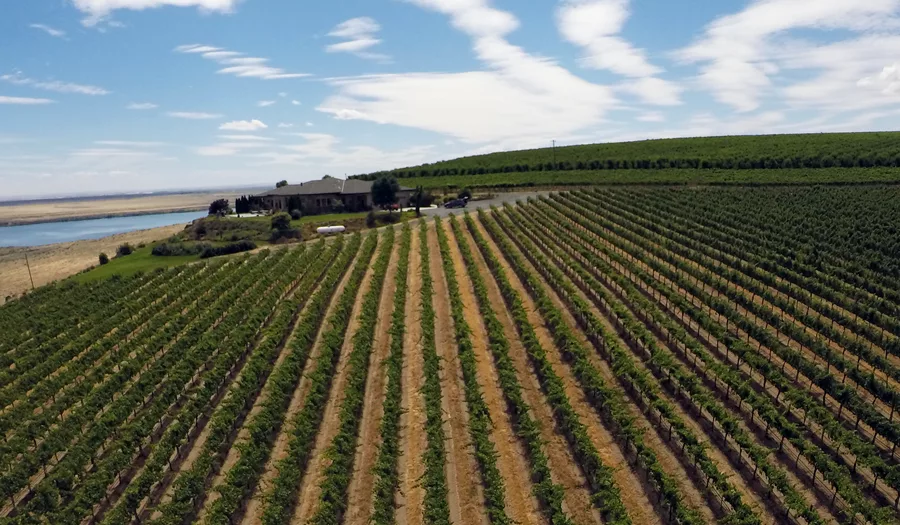
Home » Cabernet reigns supreme as state’s top grape
Cabernet reigns supreme as state’s top grape

April 15, 2019
By Andy Perdue
Cabernet Sauvignon is the king of Washington wine country.
Washington winemakers harvested 261,000 tons of wine grapes
in 2018, up from 229,000 tons in the previous year, based on numbers released
in March by the Washington Wine Commission.
Washington is the No. 2 producer of wine grapes in the
United States, second only to California.
Leading the way was Cabernet Sauvignon, a red grape that
originated in France’s Bordeaux region and is the grape that has done the most
to make California’s Napa Valley famous. In Washington, Cab was No. 1 with
74,400 tons picked, up from 62,800 in 2017.
As recently as 2014, Washington picked 42,200 tons of Cab, a
trend that has been driven by Ste. Michelle Wine Estates, Washington’s largest
and oldest wine producer. With brands that include Chateau Ste. Michelle, 14 Hands and Columbia
Crest, the company uses two out of every three grapes grown in Washington. It
appears as though Ste. Michelle’s thirst for Cab has slaked, according to Kevin
Corliss, vice president of vineyards for Ste. Michelle Wine Estates.
“We have plenty of Cab now,” he said. “I expect Cab
production numbers to plateau.”
In fact, he said, the company is looking to replant many of
its older vineyards, replacing vines that were diseased or planted to varieties
that aren’t optimal to the location. If anything, that could drive numbers down
a bit next year until new vines come into production, which typically takes
three to five years.
Overall, red varieties continue to dominate, with nearly 60
percent of the state’s overall production. Merlot accounted for 37,500 tons last
fall, up from 33,000 tons in 2017. At No. 3 is Syrah at 24,300 tons, up a bit
from the 21,000 tons harvested in 2017. Syrah is traditionally blended with
other varieties to boost flavor and balance in the resulting wines.
On the white wine side, Chardonnay led the way with 41,500
tons, up from 39,600 tons in 2017.
Riesling followed with 38,300 tons, again up a bit from
33,200 tons the previous vintage. Chateau Ste. Michelle produces more than a
million cases of Riesling each year, making it the largest producer of Riesling
in the world.
As recently as 2014, Washington was led by white wine, but
starting in 2015, the trend to red has grown. Red grapes often cost more per
ton, and the resulting wines command a higher price. In 2018, Cabernet
Sauvignon brought in an average of $1,505 per ton, making Cab Washington’s most
prized grape crop. Petit Verdot commanded the state’s highest average amount,
at $1,675 per ton. By comparison, Chardonnay only averaged $939 per ton.
Overall, Washington wine grapes averaged $1,213 per ton, up from $1,206 in
2017.
In addition to quantity, wineries are happy with quality.
Corliss said it was a warm year with little disease issues. The warm, sunny
autumn meant no early frosts, so winemakers could let their fruit hang on the vine
until optimal flavors were achieved.
Chris Figgins, president and head winemaker for Leonetti
Cellar in Walla Walla, said he is pleased with what he sees in barrel,
comparing the quality of the 2018 vintage to 2012, widely regarded as one of
the top vintages in Washington history. A fuller picture of the quality will
come into focus as the new red wines are released this summer and fall.
Wine honors
Scott Williams, second-generation winemaker at Kiona
Vineyards and Winery in Benton City, was named honorary grape grower for the
2019 Auction of Washington Wines, an annual fundraiser that will take place
this summer in Woodinville. Scott’s father, John, was the first to plant grapes
on Red Mountain in 1976.
The honorary vintner was Chris Gorman of Gorman Winery in
Woodinville.
Dust Devils to sport wine grapes on uniform
The Tri-City Dust
Devils baseball team unveiled a new uniform that honors the region’s wine grape
industry.
The purple uniforms
include a cluster of grapes. The minor leaguers will play in the new look for
three games under the name Viñeros de Tri-City. This is the Northwest League’s
effort to honor the community’s
diversity. The Dust Devils worked with the Tri-Cities Hispanic Chamber of
Commerce to come up with the new look. The team will wear the uniforms June 20,
July 18 and Aug. 22.
Canvasback to open new tasting room
Canvasback, a Washington winery owned by Napa Valley-based
Duckhorn Vineyards, plans to open its first tasting room this spring south of
Walla Walla. The winery launched in 2013 with a Cabernet Sauvignon from Red
Mountain and has since added a reserve-tier wine.
In 2013, it bought and planted a 20-acre vineyard on Red
Mountain and has since boosted production to nearly 20,000 cases of wine per
year, which it sells in all 50 states and exports to Asia and Canada.
The tasting room, which will be in the old Waters Winery
building on J.B. George Road south of downtown Walla Walla, will open in April.
It has expanded its wines up to 10 wines, primarily from Red Mountain and Walla
Walla Valley vineyards.
Andy Perdue, editor and publisher of Great Northwest Wine and founding editor of Wine Press Northwest magazine, is the wine columnist for The Seattle Times.
Local News Agriculture
KEYWORDS april 2019





